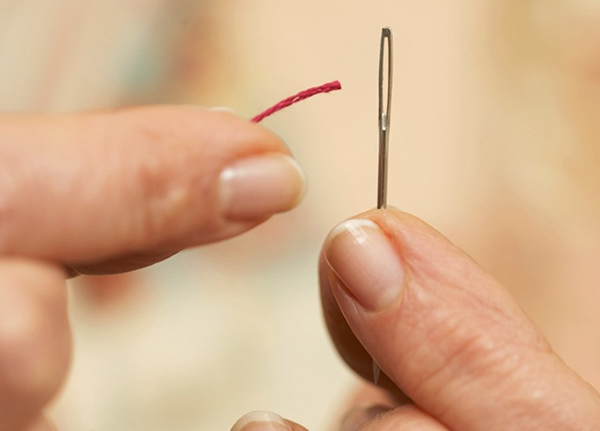 By Lynn Jensen, Independent Living Skills Specialist, VLRC
By Lynn Jensen, Independent Living Skills Specialist, VLRC
Many people who love to sew find threading a needle can become a big challenge after they lose their sight – but it doesn't have to be.
There are many commercial needle threaders available to the general public, including self-threading needles, wire-loop threaders, and the Infila needle threader available at Shop CNIB. But, my all-time favourite trick for threading a needle is a good old-fashioned floss threader from the local drugstore!
Floss threaders are used by people who have braces or a bridge in their mouth. It is a nylon loop designed to resemble a needle with a large opening to thread dental floss. A floss threader is basically a large-scale version of the popular wire loop threader.
In order to thread a needle using a floss threader, the user passes the thread through the loop of the floss threader, inserts the stiff point of the floss threader into the needle eye, and finally pulls the floss threader and thread completely through the needle's eye until the floss threader is released by the thread and the needle is successfully threaded.
Follow these simple steps to thread a needle with a floss threader:
- Cut a length of thread that is preferred for hand sewing.

Floss threader
- Pass one end of the thread through the large loop at the end of the floss threader. This can be made easier by placing your thumb and index finger of your dominant hand through the loop of the floss threader, pinching one end of the thread between the thumb and index finger, and pulling these pinched fingers back out of the loop. You now have the thread passing through the loop of the floss threader. Ensure that one end of the thread is much longer than the other end. You can now let go of the thread and focus your attention on the stiff end of the floss threader.
- Pinch the stiff end of the threader between the thumb and index finger of your dominant hand. You want the stiff pointy end of the floss threader to barely stick out from the end of your thumb and index finger. The shorter it is, the easier it will be to thread the needle.
- Bring the eye of the needle up to the stiff point of the floss threader. Slowly rotate the needle until the point of the floss threader slips through the eye of the needle. When it does, continue pulling the floss threader through the eye. The floss threader will bring the thread with it. Keep pulling the floss threader through the needle eye until the floss threader is released from the thread – Congratulations, you just threaded the needle!
You may prefer to keep the needle in the pin cushion while threading it in this manner. In addition, you may like to use scissors to cut the stiff straight point of the floss threader on an angle to help ease it through the eye of the needle.
When I teach people who are blind to thread a needle using this method for the first time, I like to use an embroidery needle for increased likelihood of success. The embroidery needle has an elongated eye, whereas the eye of a sharps needle is circular in shape. It is important to note that floss threaders will work for threading sewing machine needles, but they will not fit through the eye of finer needles used for sewing silk. Additionally, this same method for threading a needle can also be used to tie hooks, lures, and swivels to fishing line.
If you'd like to learn additional adaptive sewing skills, like sewing on a button, contact your local Vision Loss Rehabilitation Canada location. Good luck!